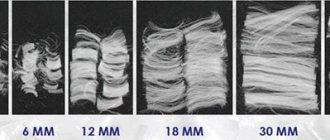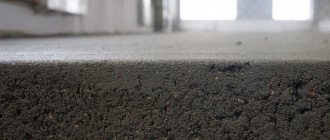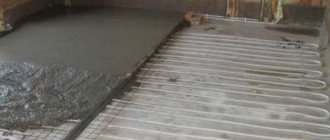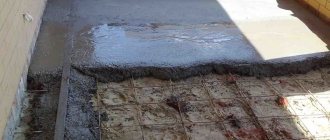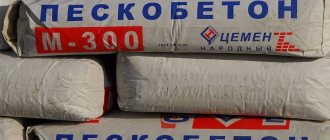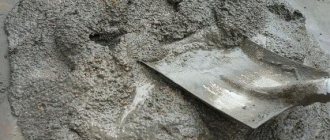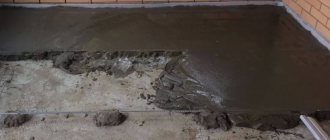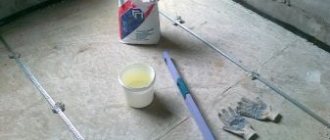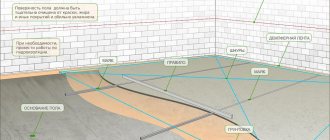Types of fiber fiber and their characteristics
Manufacturers of building materials have launched the production of several types of fiber fiber. They differ in material of manufacture and purpose.
Fiberglass
In the production of this type of soft reinforcement, zirconium is used. This material does not rot, has excellent corrosion resistance and does not produce harmful fumes. Glass fiber is produced up to 18 mm long and up to 10 mm thick.
Glass fiber is added to plaster mortars, in mixtures for the preparation of foam concrete and aerated concrete blocks, and is used for casting decorative products and soundproof barriers. The main feature of glass fiber is its ability to maintain the integrity of thin (up to 3 cm) layers of concrete.
Recommended consumption per m3 is 900 grams. Fiberglass is classified as a material in the middle price category and is not used for organizing screeds.
Steel fiber
To produce this product, thin high-carbon steel wire is used. The thickness varies from 0.2 to 1.2 mm, and the length &mdsah; from 5 mm to 150 mm.
Steel fiber fiber is used for the construction of monolithic reinforced concrete structures intended for the construction of critical industrial facilities (bridges, runways, fortifications).
It is not recommended to use steel fiber for screeds, since in thin layers the metal fiber causes local ruptures. This process occurs due to different coefficients of expansion of materials at the moment of temperature change.
The use of steel fiber fiber allows you to achieve the following advantages:
- labor costs are reduced by almost a third;
- the cost of the product is reduced to 7%;
- the bending resistance of concrete increases by 2 times.
Significant disadvantages that arise when using steel fiber include reduced noise absorption of the concrete base. Up to 50 kilograms of steel fiber must be added per cubic meter of mixture.
Basalt fiber
It is made by melting rocks at high temperatures. Basalt fibers are produced with a thickness of up to 500 microns and a length of up to 15 cm. This material for organizing the reinforcement of concrete solutions is considered the most suitable for construction work. It allows you to achieve the following improvements:
- resistance to shock loads increases 5 times;
- bending resistance increases by 3 times;
- resistance to compression and stretching is improved by 1.5 times;
- frost resistance increases by 2 times;
- water resistance improves 1.5 times;
- abrasion resistance is improved by 3 times.
Basalt fiber consumption is up to 2.3 kg per m3.
Polypropylene fiber
Obtained by extrusion of polypropylene mass, as a result of which individual fibers up to 20 microns thick and up to 20 mm long are obtained. The use of this material for reinforcing screeds slightly increases the strength characteristics of concrete, but the positive aspects of using polypropylene fiber include improved sound insulation.
In construction, polypropylene fiber is used for floor screed. Consumption per m2 is determined by recalculating the required volume per cubic meter of concrete, which is up to 900 grams per 1 m3.
What is it and why is it needed
Fiber fiber, or simply fiber, is a reinforcing additive in various building mixtures and solutions. By adopting a chaotic arrangement inside the concrete, it improves its quality characteristics, such as abrasion, strength, etc. In addition, fiber-fiber concrete better resists bending and tensile loads. All this is very important for floor screed.
Fiber is very strong thin fibers ranging from 6 mm to 20 mm in length. The size of reinforcing additives affects the characteristics of concrete differently, so the following is used:
- 6 mm - in mortars for cladding and masonry;
- 12 mm - screeds and various monolithic concrete products;
- 18-20 mm - in structures operated in extreme conditions, for example, dams.
It is produced in the form of crumbly material from glass, metal, basalt and polypropylene. It begins to influence the screed already at the stage of mixing the solution - it actively influences future physical and chemical processes that will begin after pouring, in two directions at once.
1. A solution with reinforcing additives requires less water to completely mix. Consequently, during the hydration process, the screed will gain strength faster, and excess moisture will not actively evaporate, forming microvoids and a network of small cracks.
Illustration of fiber distribution inside concrete.
For information: in any solution there are voids. In a traditional mixture of cement and sand, they are filled with water; in a reinforced mixture, they are filled with fibers. Therefore, you need less water up to 20%.
2. By filling all voids after pouring, fiber fiber prevents the formation of microcracks in the first 5-7 hours of setting of the solution.
For information: at the initial stage of hydration, internal stresses appear in the pouring body due to micropores and different rates of hardening, which manifests itself in a network of cracks on the surface of any concrete product. The use of reinforcing fibers allows, firstly, to fill voids and, secondly, to evenly distribute moisture inside the concrete product, as a result of which the hardening process proceeds evenly, which reduces internal stresses to zero.
At the second stage of hydration, when ordinary concrete begins to shrink and cracks appear, the fiber fibers hold the screed in its original dimensions, as a result of which cracks do not form. If they do appear, then due to the multidirectional effect of the reinforcing fibers on the concrete surface, the resulting gaps between the cement particles are tightened.
Fiber fiber for screed - consumption per m2 is calculated according to its need per m3
Thin polypropylene fibers of short length can significantly strengthen the cement layer, making it more durable and ductile. Regardless of the percentage of the mixture and for what specific purposes the fiber screed will be used, the consumption per m2 of the surface to be laid is determined according to generally accepted figures relating to the amount of fiber for 1 m3 of solution. The calculation is made taking into account the thickness of the concrete layer and the area of the room being equipped.
Properties and qualities
Polypropylene fiber is added, among other things, to semi-dry screeds.
Fiber fiber is evenly distributed throughout the entire volume of the mortar mass, which prevents further formation of cracks and shrinkage, reduces the abrasion coefficient of the surface and reduces the moisture absorption rate. Fiber is an artificial material in the form of polypropylene fibers of translucent white color. Their diameter is about 20 microns, and their length ranges from 3...18 mm. Moreover, each size has its own area of application:
- for facing work and masonry - fibers up to 6 mm long are used;
- for screeds and monolithic structures – no more than 12mm;
- for semi-dry screed and during the construction of hydraulic structures - 18mm.
Reinforced fiber is characterized by low electrical conductivity and has a sliding effect, ensuring the most uniform mixing of fiber with cement. As a result, the composition acquires viscosity, which subsequently affects the good density and load-bearing capacity of concrete.
High-quality fiber fiber has no obvious disadvantages. Another thing is an uncertified product from an unknown manufacturer. Over time, if not immediately, such material may begin to release hazardous substances that can cause harm to health. This is very dangerous, especially when laying mortar in residential areas.
As a result of using a polypropylene fiber solution in a batch, a new material appears that has a lot of positive properties. This type of concrete:
- has a minimum number of voids and small cracks - the mixture evenly fills the prepared space, and the fibers cover the cracks at the slightest shrinkage;
- contains a minimum number of pores, thereby increasing the moisture resistance of artificial stone;
- has plasticity, allowing the material to be used in earthquake-prone areas;
- is not subject to the processes of delamination, sprinkling and chipping;
- withstands a much larger number of freeze/thaw cycles compared to conventional concrete;
- is characterized by strength, frost resistance and durability;
- weakly responds to mechanical stress, including abrasion;
- Unaffected by most deicers.
Fiber fiber compares favorably with metal fine-mesh reinforced mesh. Its individual particles do not lie in a single-level layer and do not bunch up into lumps, but are evenly distributed throughout the entire volume of the screed or concrete structure. The growing popularity of polypropylene is also facilitated by its affordable price and compatibility with additives intended for concrete solutions.
The fiber reinforced screed has a perfectly flat surface, just like a layer of plaster applied to the wall.
How to determine fiber consumption per 1m2
In a high-quality mixture, all ingredients must be thoroughly mixed. This can be achieved by first combining the dry cement composition with the required amount of polypropylene fibers. Water should be added to the solution in portions, bringing it to the desired consistency.
Kneading recipes depend on the requirements for the finished composition. For 1m3 of solution it will go:
- 300g fiber, if it is needed only as a plasticizer;
- up to 600g of fiber, if it is expected to increase the strength characteristics of concrete;
- more than 800-900g of fiber, when it is necessary to create a cement stone that has absorbed the best qualities of polypropylene.
If we consider the consumption of fiber fiber per 1 m2 of cement screed, then we will have to focus on the thickness of the layer being laid. For a 50mm high strength leveling deck you will need 40g of fibre. The figure did not come out of thin air, but from an ordinary mathematical proportion.
The fact is that a volumetric cube differs from a flat square in the presence of a third dimension, namely depth. For meter cube sizes it is 1000mm, and for our screed it is 50mm, i.e. 20 times less. Consequently, in this case, fiber fiber will be needed the same amount less. So, 800/20=40g. To obtain the final calculation, the actual area of the room in m2 should be increased by 40 times. The resulting figure will indicate the amount of fiber in grams. In fact, everything is simple and clear.
Video description
This video talks about all types of fiber for screeds:
Approximate prices for fiber per 1 kg:
- Polypropylene – 200-300 rubles.
- Basalt – 160-240 rub.
- Fiberglass - 100-180 rubles.
- Steel – 50-65 rub.
- Carbon – 2500-4000 rub.
But the price of the material in itself does not mean anything; it must be considered in conjunction with the consumption rate. Let's compare the cheapest steel fiber with carbon fiber, which has the highest cost.
Steel fiber for concrete – consumption per m³ averages 40 kg. With an average cost of 58 rubles we get:
40 x 58 = 2320 rub.
The same volume of solution requires only 1 kg of carbon fiber, costing about 3,000 rubles.
The final difference is not as noticeable as the price per kilogram of product.
Mixing the solution with fiber fiber
The use of fiber does not make any noticeable changes in the process of mixing the solution. The main task is to evenly distribute the fibers in the mass of sand concrete for its volumetric reinforcement and prevent the formation of lumps. To do this, first mix all the dry ingredients and then dilute them with water.
Type of finished solutionSource wexy.ru
The fiber consumption per 1 m² of screed or per batch is calculated based on the proportions. If 600 grams of fiber are required for 1 cubic meter of concrete, then 5 times less is poured into a concrete mixer for 0.2 cubic meters - 150 grams.
Label from basalt fiber packagingSource ognebio61.ru
The finished solution is immediately poured onto the base and leveled using the rule. This technology compares favorably with reinforcing the screed with a mesh, which must be laid out and fixed at a certain distance from the floor. Fiber, in contrast, is evenly distributed throughout the entire thickness of the screed and reinforces it in all planes from top to bottom.
Proportions and rates of fiber consumption when installing floor screeds
- The recommended consumption of fiber for floor screed is 1% of the mass of cement; with this proportion, flexural strength increases by 50 - 70%, compression strength by 15 - 30%, respectively, reinforcement of the screed with metal mesh is no longer required.
- When installing industrial floors on a solid base, up to 12 cm thick, it is recommended to add basalt fiber in an amount of 1% by weight of cement, such reinforcement is an alternative to metal mesh, and the surface strength increases by 60%, impact strength increases by 3 - 5 times, eliminates cracking and delamination of concrete.
- When installing floors in industrial premises on the ground, and when they are exposed to high loads during operation, it is recommended to use fiber together with reinforcement or metal mesh. Recommended fiber length is 12-16mm.
How to reinforce a screed with material
Before tiling the floor, it is first filled with a cement composition to level it and make it more reliable. The solution is made from cement, sand, polypropylene fiber and water. In addition to the materials listed, you will need the following tools:
- building level;
- aluminum profile;
- ruler;
- Master OK;
- putty knife;
- rake-rule;
- roulette;
- a drill with a special attachment for mixing cement mortar;
- screwdriver;
- self-tapping screws
First, the foundation is prepared. Debris is removed from it, and then cracks and recesses found on the floor are sealed using putty. After this, wash it and wait until it dries completely.
You can learn how to prepare cement mortar for plastering walls from this article.
Then the levels are set with marks on the walls. This stage of work begins from the corners of the room. Instead of beacons, wooden blocks or self-tapping screws with plastic tips made from corks are used. They must be fixed with cement.
After such preparatory work, you can proceed to preparing the solution. First, the dry ingredients are mixed - sand and Portland cement. The proportions are maintained at 3:1. Then half the volume of fiber fiber is added to them. After thorough kneading, the mixture is diluted with water, and the remaining fiber mass is introduced in small portions. If you use traditional technology, it is useful to read about what mixtures are used for floor screed.
In the video, reinforcement of the screed with fiberglass:
If such a fiberglass screed is used to create a heated floor, thermal insulation must be provided. It is laid on a dried base, and after it is filled with the prepared solution. Typically the layer thickness is 30-50 mm. The plane is leveled using a rule. Please note that the next layer is applied only after the previous one has dried.
After leveling, the resulting surface is rubbed with a grinding device, which hardens the surface. It is produced 20 minutes after pouring. The resulting screed must be covered with polyethylene to protect it from drafts. For proper hardening, it must stand for at least 12 hours. After four days, a decorative layer of the selected floor covering can be laid on its surface.
Fiber fiber is an excellent alternative to reinforced mesh. It costs less, and gives the cement screed properties that the latter cannot distinguish. The work will not take much time; the only factor on which the quality of the screed will depend is the correct creation of the solution and its pouring. You can do it yourself, but for those who doubt their abilities, it is better to hire specialists. In any case, when performing such a screed, the base will be smooth, frost-resistant, moisture-resistant and thermally conductive.
Materials, tools, equipment
Compared to the conventional process, semi-dry screed with fiber fiber looks more attractive - it is simpler. For work you will need to prepare the following materials:
- Portland cement M400 (M500);
- sand, preferably river sand, since quarry sand will have to be sifted and washed to remove clay;
- fiberglass;
- plasticizer, its replacement is liquid soap;
- damper tape;
- plastic film.
A master cannot do without some items, tools and equipment. You need to have on hand:
- painting strip (twine rubbed with chalk);
- guides - beacons;
- rule;
- construction pencil;
- roulette;
- level: hydraulic or laser (preferably the latter);
- concrete mixer;
- concrete shoes;
- large capacity for solution;
- trowel;
- trowel (trowel);
- bubble level;
- putty knife.
How much to add?
With different amounts of added fiber fibers, a solution with different technical characteristics is obtained. The solution consumption is calculated per 1 m2. Cement and sand are mixed in a ratio of 1: 3, then reinforcing materials are added to the resulting dry mixture, and then water is added to obtain a semi-dry mixture consistency. Calculation of dry material consumption is in grams per 1 m3 of solution. Of course, the greater the weight of the additive, the stronger the screed will be, but there are also certain standards:
- If the proportion of fiber is 300 g, then the concrete lays down easier, becomes more plastic, and fills cracks.
- If you add 500-600 g, the strength of the finished layer will increase significantly, and shrinkage cracks will not occur when drying.
- When adding 800-900 g, concrete gains its maximum strength and acquires all the properties of a reinforced layer.
- Fiberglass fiber is consumed in the amount of 1 kg per 1 m2.
- Popular polypropylene fiber is sold in 10 kg bags. There is a packaging of 18 kg: in a bag - 20 bags of 900 g or 30 bags of 600 g. This packaging is convenient for preparing a solution.
How to make fiber-reinforced concrete?
Initially, the dry components of the solution are placed in a concrete mixer, according to its manufacturing technology, brand and strength class of the material. Depending on where the concrete monolith will be located and under what load it will be operated, the type and amount of fiber fiber is selected. After dry mixing, water is added to the composition, and plasticizers are used if necessary. Thanks to the use of fiber, the amount of water and cement required is reduced.
The mixing time will be 7-10 minutes, while you need to monitor the state of the solution and, if necessary, add water or a plasticizer. This is done to ensure that the mobility of the solution is optimal for the work, there are no voids left in it, and the composition is uniform.
For small volumes in private construction, fiber-reinforced concrete can be made with your own hands in another way. Fiber fibers are filled with water and stirred for uniform distribution. After this, cement or dry construction mixture and other fillers are added to the water until the desired composition is achieved. Constant mixing during production ensures correct distribution of fiber throughout the entire volume of the concrete mixture.
Types of fiber fiber
Let's briefly get acquainted with the main types of fiber fiber. All of them are presented in the table below.
Table. Fiber fiber - classification by material.
| Material | Peculiarities |
| Metal | It has high strength characteristics and an average service life. It is used to create volumetric structures made of concrete with large mass and dimensions. |
| Basalt | The main advantage is high resistance to ignition. It is also environmentally friendly. |
| Fiberglass | Individual particles of fiberglass fiber are large in size. It is used when it is necessary to impart greater plasticity to the cement-sand mixture. |
| Polypropylene | The cheapest type of fiber for concrete. It is this type that is most often used in private construction, including when creating floor screeds. |
Production of polypropylene fiber
Important! When purchasing a large amount of fiber fiber, make sure that the product has all the necessary certificates and is not a counterfeit. This is especially important when purchasing polypropylene fiber.
Polypropylene fiber fiber
Video - Floor screed with the addition of fiberglass
Qualitative improvement of concrete monolith
Qualitative changes in the monolith are a subject of special attention when using steel fiber fiber. The reinforcing role of steel wire in this case becomes a determining sign of its effectiveness. This is worth taking a closer look at:
- homogeneity of the mortar and monolith - fiber, unlike thick reinforcement, does not have a strictly defined localization in the structure, so it more evenly accepts and distributes loads;
- when pouring a solution, thin fibers do not reduce its plasticity, but make it possible to reduce the density of reinforcement in hard-to-reach places, which gives the effect of quickly filling the formwork;
- the need for vibration laying is reduced;
- As the cement hydrates, a layer of binder forms around the fibers, which limits contact with water and air, preventing oxidation and corrosion of the metal.
In the production of steel fiber fibers, a special technology is used - the shape of the wire pieces is optimized for maximum adhesion. Thus, the reinforced concrete structure is given improved characteristics in terms of strength and ductility. Increasing the critical tensile load threshold is an example of a significant change in quality characteristics that are extremely important in complex projects.
What to look for when buying fiber
Buying low-quality fiber is not only a waste of money, but also a risk of ruining the structure. Concrete structures are manufactured with strength and long service life in mind. The use of low-quality materials can lead to significant losses.
For example, you can find handicraft polypropylene fiber on the market. In appearance, it differs little from factory fiber, but is manufactured in violation of technology. High-quality fiber contains a component called lubricant. It prevents fibers from clumping and promotes their uniform distribution in the solution. The fake fiber will crumple, and the formation of a three-dimensional frame in the thickness of the concrete will not occur, which means that the concrete will not receive the properties that were expected when the fiber was added. By “saving” a few rubles, you can incur significant losses.
To avoid such situations, purchase fiber from trusted manufacturers from reliable suppliers.
Advantages and disadvantages
The use of fiberglass for floor screed allows you to achieve a significant qualitative improvement in the cement-sand mortar. The positive results of using this supplement include the following:
- Fiber increases the resistance of the material to shock and vibration loads. The concrete base becomes much stronger, while it is able to withstand long-term static loads.
- The fiber-fiber material is located inside the concrete mixture in a chaotic manner, which makes it possible to effectively consolidate the mixture and avoid delamination. The uniform distribution of reinforcing fibers during hydration makes it possible to eliminate such an unpleasant phenomenon as explosive spalling of the finished screed, which occurs when different parts of the solution set at different times.
- Fiber reinforcement improves the characteristics of concrete for resistance to temperature changes, as a result of which the number of cycles increases significantly, and therefore this type of reinforced concrete is recommended for use in areas with unfavorable natural conditions.
- When using fiber to create a screed using the wet method, natural shrinkage does not occur, since the fibers reinforcing the solution do not allow voids to form. In addition, when using fiber fiber, a smaller volume of water is required, and it is the excess of this component that causes concrete shrinkage.
- With the final gain of concrete strength, the internal stress decreases, which makes the screed more durable and elastic.
When using certified fiber fiber, there are simply no negative manifestations. Problems can only arise if the methods for preparing a solution with fiber are violated or if low-quality material is used. It is best to purchase fiber fiber from reputable suppliers or, when purchasing from random sellers, require a quality certificate confirming the legal origin of the raw materials.
Fiber fiber screed installation technology
As with the installation of a conventional screed, you need to prepare the surface, mark the level of the subfloor, properly prepare the concrete solution and perform installation according to the described technology for performing the work.
Surface preparation
We remove the old floor covering, inspect the slab for defects and protruding reinforcement.
Sequence of preparatory work:
- We expand the cracks using a grinder, clean their edges, and seal them with cement-sand mortar mixed in a 3:1 ratio. In order for the concrete to set better, we wet the surface generously.
- Remove dust from the stove with a vacuum cleaner.
Screed level marking
Before you start marking, find the highest and lowest points of the floor
The thickness of the fiber screed and the proportions of mixed materials depend on differences in floor height and the functional purpose of the room.
Find the lowest and highest points on the floor using a laser or water level. We make a mark on the wall, draw a horizontal line along the height of the future screed.
According to the markings, we install the guides parallel to each other in increments of 15-20 cm. We take into account that the distance between the beacons should be less than the width of the tool for distributing the solution. For more information on how to do this using a laser level, watch this video:
We use smooth profiles as beacons and place them in a horizontal plane. To fix a certain height, we use bars or fix beacons to cement mortar.
Preparing the solution
We prepare a solution with the addition of fiber for the screed.
There are several ways to mix components:
- Mix the dry ingredients well: cement, sand, fiberglass. Then add them to water and mix thoroughly until a homogeneous mass of creamy consistency is formed.
- The fiber is added to the cement laitance, then introduced into the prepared cement mortar and mixed well.
- Throw it into a concrete mixer with the prepared solution. Watch all the details of the kneading process in this video:
Preparation of high-quality concrete mortar with fiber:
- Mix the dry ingredients well: 3 parts sand, one part cement. Add half the volume of fiberglass. Mix all the ingredients.
- Add 400-500 ml of water per 1 kg of cement.
- Add the remaining fiber in small parts and mix thoroughly.
The solution should have a uniform consistency, like thick sour cream.
We select the brand of cement according to the classification in the table:
| Concrete grade | Application | Cement consumption in kg per 1 cubic meter of concrete |
| M 100 | Lowest strength, used for concreting curbs and fences | 165 |
| M 200 | Used for installation of screeds and foundations | 240 |
| M 300 | It has high strength and is used for installation of foundations, floors, etc. | 320 |
| M 400 | Has the highest strength, withstands load-bearing bridges and overpasses | 417 |
Fiber consumption
The amount of fibers added to the cement mortar depends on the requirements for the screed.
| № | Fiber consumption | Characteristics of the screed |
| 1 | 300 g per cubic meter m | Slightly increases the binding function and makes working with the material easier. This proportion works as an additive that slightly improves the quality of the screed. |
| 2 | 600 g per cubic meter m | The ductility, resistance to moisture penetration, strength and service life of the coating will significantly increase. |
| 3 | 800 to 1500 g per cubic meter m | Maximum efficiency is achieved. |
The ratio of the number of fibers to a certain volume of cement is indicated on the packaging or in the instructions for the fiber for the screed.
Filling the screed
Let's look at how to properly make a screed with the addition of fiber. For more information about pouring semi-dry fiber screed, watch this video:
We start work from the far corner of the room. The floor must be poured in one go without interruptions.
Stages of work:
- Pour the cement mortar with fiber onto the floor between the guides and level it using a long-handled rule.
- We compact the mixture so that air bubbles come out and no voids remain, using a needle roller.
- After a day, we take out the guides and fill the places where they were with solution.
DIY concrete additives
The basic characteristic of concrete and cement-containing mortars is the compressive strength of the finished products. The process of setting and strengthening of the poured mortar is tied to the hydration of the cement.
The minerals included in its composition react with water and atmospheric carbon dioxide, which leads to the creation of a strong crystalline structure, which, in turn, binds the filler: sand, gravel, slag, crushed stone, expanded clay....
In this article we will touch on the main additives in concrete and cement mortar, which modify their properties and which you can make with your own hands in the living conditions of an apartment or cottage.
DIY cement mortar and concrete, what it is and why - introductory
In fact, this is the simplest version of concrete: a mixture of cement mortar with coarse sand.
It is mainly used as substrates for foundations or as a filler for metal forms (piles).
Very little water is required for the solution - only for convenient stirring and hydration of the cement. It is possible to mix the mixture directly in the pouring mold or formwork.
Usually crushed stone with a fraction from 2-3 mm to 30-35 mm is used
Important!: crushed stone, like any other filler, must be clean! It is also recommended to use aggregates of different sizes with non-smooth surfaces, i.e.
extracted by crushing rocks.
In the recipes below we will assume that 1 bag of cement is 50 kg. unless explicitly stated otherwise.
So, how to prepare concrete yourself:
- Prepare the mold or formwork.
- We choose aggregate with different sizes, for example, mixed large gravel or crushed stone with medium. Because at home, there is usually no equipment for high-quality compaction of concrete - it is the different size of the stone that will ensure a tight fit of the aggregate elements to each other, which does not allow the formation of large voids.
- Mix sand and cement in a trough, bucket or concrete mixer.
- We fill in water, which should be as clean as possible and without any extraneous alkaline or acidic inclusions.
- Little by little we begin to add cement and aggregate, stirring constantly.
- After mixing thoroughly!!!, pour the prepared solution into a mold or formwork and, if possible, compact it using improvised means.
Proportions in concrete preparation technology are not given, because For different purposes, different compositions are required.
Foundations for a house or large buildings require the inclusion of large aggregates and the cement mortar needs to be sufficiently fluid and in an amount sufficient to adhere/fix them.
The most common proportions of concrete mortar are 1:3:6, where respectively cement, sand and aggregate + 0.5-1 water. The component-wise composition of concrete is set out in GOST 7473-94 and SNiP 5.01.23-83.
DIY plasticizers
History knows many recipes and techniques for improving the characteristics of concrete.
For example, already in the 19th century, to increase plasticity and adhesion, protein from a chicken egg was added to the solution; in the 20th century, after the advent of slaked lime (fluff), they switched to it. Nowadays, at home, washing powder or other detergents are sometimes added.
What is fiber for concrete or mortar?
First, let’s define the concept of what fiber fiber is. The name itself consists of 2 identical words, only one is English, the other Russian. “Fiber” is translated from English as fiber. Fiber for concrete is thin threads made from different materials. They have different lengths, thicknesses, and cross-sections.
Helpful information:
- Concrete calculator: composition calculation
- Proportions of concrete for the foundation
- Liquid glass for concrete
- Plasticizer for concrete: types and applications
- How much does a cube of concrete weigh?
- Composition of M300 concrete per 1m3 (tables)
Why were they invented? Previously, and even now, during serious construction, the flexibility and strength of the monolith is increased by metal structures and meshes. This is a very costly and time-consuming undertaking. Therefore, to speed up the process, they came up with adding fine fibers directly to the mixture. They also form a mesh and play the role of micro-reinforcement. With the correct addition of fibers, concrete becomes more flexible, does not shrink strongly and does not crack.
Let's take a closer look at the process that occurs when cement hardens. It looks like this. Thin threads are located in the solution at different angles, intersecting, creating a mesh. This mesh prevents the components of the cement-sand mixture from changing their position. Sand grains do not settle to the bottom, and small particles of cement do not migrate to the surface. When the mixture sets, the fibers glue the particles of the mortar together, hold them in place and prevent the appearance of cracks during shrinkage.
When advertising their product, manufacturers of the reinforcing additive attribute to it the following positive properties:
- Unlike metal reinforcement, which creates increased strength due to its design, microfiber fibers create a three-dimensional mesh and strengthen the monolith itself. Therefore, this additive is used to produce not only floors, foundations, but even just concrete blocks.
- Fiber fibers improve concrete strength, flexibility and vibration resistance so well that this additive is used for masonry mortar in earthquake-prone areas. They are also used for the construction of military, industrial facilities, and railway sleepers.
- Microfibers, which consist of synthetic material, do not enter into chemical reactions. Therefore, aggressive liquids cannot affect the strength of the structure. Villi also fill the pores. This makes the concrete waterproof and resistant to temperature changes.
- Reinforcing threads make the surface resistant to abrasion. This quality is used for the construction of surfaces with increased traffic load.
- Fiber fiber promotes faster hardening of the cement composition. This quality is used in the production of casting molds. In addition, defects and damage to products during transportation are reduced.
- Microfibers increase the plasticity of the solution and reduce cement consumption by 20%. The good flexibility of the solution allows you to make a screed with a small amount of water. A large number of fibers, on the contrary, makes the cement less pliable. In this case, it is recommended to add plasticizers.
- Decorative products made from fiber-reinforced concrete retain their attractive appearance for a long time and do not chip or crack.
As you can see, fiber fiber is simply an elixir of strength for concrete. If not for one “But”. You need to know exactly what type of fiber is needed for a particular application, and how much to add. Excessive consumption can only ruin everything. A large amount of polypropylene fiber reduces the strength grade. And buying a fake generally helps to waste all your money. The point here is this. High-quality fibers are treated with an anti-clumping compound. Thanks to this, the fibers are distributed almost individually inside the monolith. But the fake rolls into lumps, and there is no talk of any three-dimensional mesh.
Waterproofing impregnations and additives for concrete: how to make concrete waterproof
Fiber function
Using a classic reinforcing screed is not always convenient, and if it is laid in large areas, the installation process becomes labor-intensive.
Fiber screed is a complete replacement for the iron reinforcing mesh used for mounting the base.
The use of fiber provides the following advantages:
- The additive increases the strength characteristics of concrete, due to which the structure maintains an unchanged structure over a long period of operation.
- This fiber is endowed with increased resistance to significant temperature changes, which means that the finished floor is impervious to cold.
- Reduces the degree of moisture penetration into the screed.
- The addition of this additive shortens the drying time of the screed, and this in turn reduces the period of repair as a whole.
- The additive eliminates possible subsidence and cracks in the concrete base.
The fiber for floor screed is distributed throughout the entire volume of the solution, which cannot be achieved with a classic reinforcing mesh. Due to this, a reinforcement effect is achieved with a smaller thickness of the screed, which plays an important role in rooms where the ceiling height is a critical indicator.
Fiber fiber: consumption, recommendations for use
Application area
Recommended fiber size, mm
Fiber consumption
Industrial floors, cement concrete road surfaces
from 1 kg per 1 m 3 depending on the required strength characteristics
Screeds, heated floors
from 0.9 to 1.5 kg kg per 1 m 3 depending on the required strength characteristics
Reinforced concrete, concrete structures and products
from 0.9 kg per 1 m 3 to give structures and products increased strength and eliminate cracks
Cellular concrete (foam concrete, non-autoclaved aerated concrete)
from 0.6 kg to 1.5 kg of fiber per 1 m 3 depending on the required strength characteristics of the finished product
Dry building mixtures (self-leveling floors, plasters, repair compounds)
from 1 kg per 1 m 3 Dosage depends on the type of dry building mixture, production technology
Small-piece products, complex-profile products, small architectural forms
from 0.9 kg per 1 m 3 Fiber fiber consumption depends on product parameters, dimensions, type of binder, production technology
from 0.6 kg to 1.5 kg per 1 m³ of mixture, depending on the strength characteristics of the finished product and production technology.
Method of using fiber fiber
Option 1: Fiber fiber is poured into any concrete or mortar mixer (mixer) into the dry mixture before adding water.
Option 2: Fiber fiber is added to the cement laitance, then all other components of the concrete mixture.
